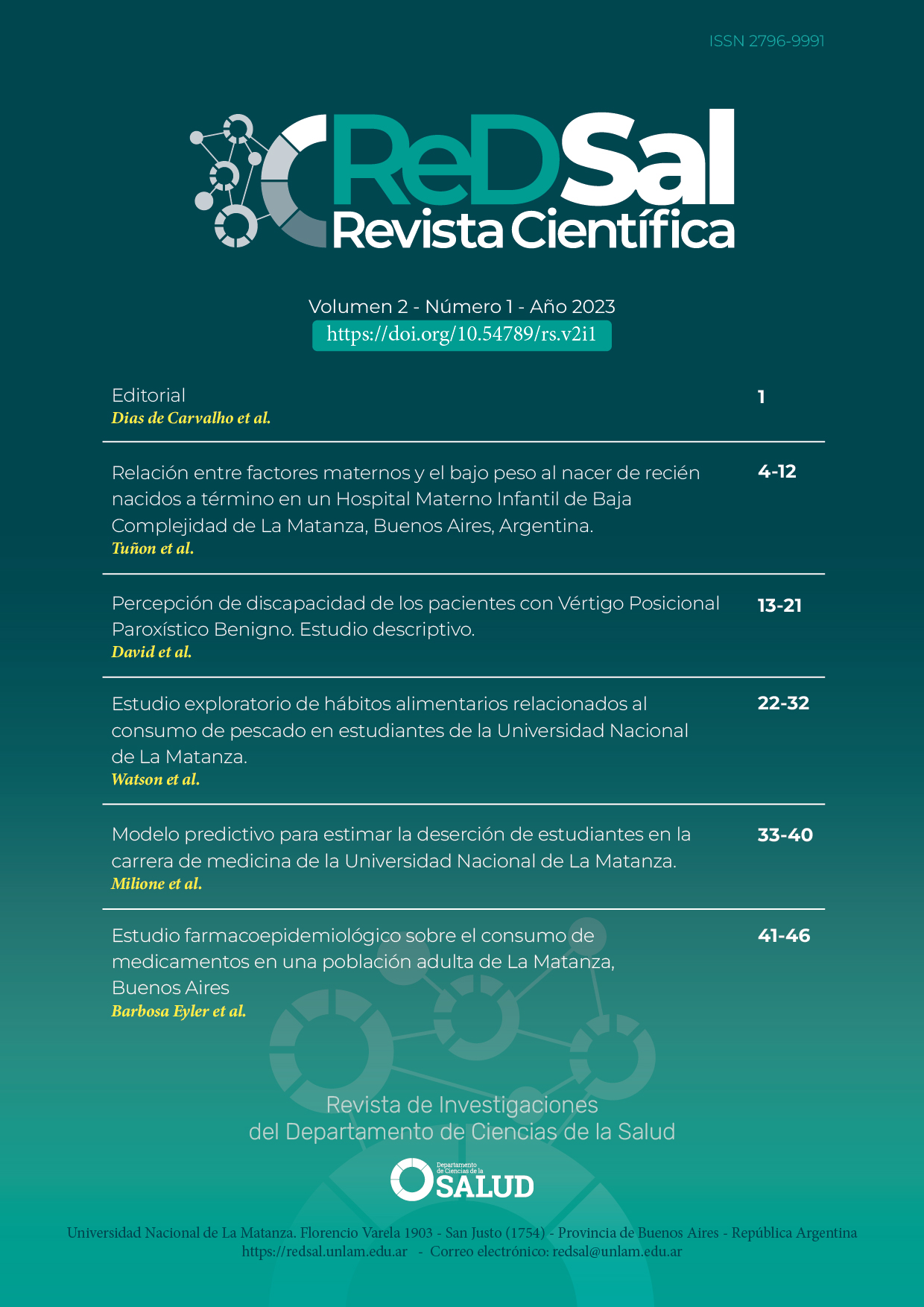Perception of disability in patients with Benign Paroxysmal Positional Vertigo. Descriptive study.
DOI:
https://doi.org/10.54789/rs.v2i1.16Keywords:
Disability Studies, Vertigo, Vestibular System, Perception, Benign Paroxysmal Positional Vertigo, Patient Health QuestionnaireAbstract
Introduction: Vertigo is a symptom defined as the subjective perception of a rotational or translational movement without the presence of external stimuli, impacting the quality of life of those who suffer from it, generating limitations and/or disability. The most common cause of vertigo of peripheral origin is Benign Paroxysmal Positional Vertigo (BPPV). An instrument created to quantify the self-perceived disability of people who present this symptom is the Dizziness Handicap Inventory (DHI). Objective: to determine the degree of disability experienced by patients with BPPV, using the DHI questionnaire.
Materials and methods: An observational, descriptive, and retrospective study was conducted. 414 medical records (HC) of patients referred to vestibular rehabilitation
diagnosed with BPPV were reviewed from January 2011 to December 2022 in a Kinesiology clinic in the province of Buenos Aires.
Results: 140 HC were included. 77% women and 23% men with an average age of 61 (+/- 15.23SD). 128 subjects (91.42%) presented BPPV of the posterior canal; 10 from the horizontal channel (7.14%) and 2 from the previous channel (1.44%). 43% of the subjects represented a mild self-perceived disability, 38% as moderate and 19% as severe. The domain that is most affected is the Physical (82%) followed by the functional (46%) and ultimately the emotional (19%).
Conclusion: The 80% of the patients in this study presented a perception of disability between mild to moderate. The physical domain of the DHI was the most affected in this group of patients.
References
You P, Instrum R, Parnes L. Benign paroxysmal positional vertigo. Laryngoscope Investig Otolaryngol. 2019;14;4(1):116-123. https://pubmed.ncbi.nlm.nih.gov/30828628/
Karatas M. Central vertigo and dizziness. Epidemiology diferencial diagnosis and common causes. Neurologist; 2008;14:355-64. https://pubmed.ncbi.nlm.nih.gov/19008741/
Pérez N, Garmendia I, Martín E, Voleas M, García-Tapia R. Instrumentos de medida de la salud en pacientes con vértigo. Acta Otorrinolaring Esp. 2000; 51:677-85. https://pubmed.ncbi.nlm.nih.gov/11270101/
von Brevern M, Radtke A, Lezius F, Feldmann M, Ziese T, Lempert T, Neuhauser H. Epidemiology of benign paroxysmal positional vertigo: a population based study. J Neurol Neurosurg Psychiatry; 2007;78:710–5. https://pubmed.ncbi.nlm.nih.gov/17135456/
Kim JS, Zee DS. Clinical practice. Benign paroxysmal positional vertigo. N Engl J Med; 2014; 370:1138–47. https://pubmed.ncbi.nlm.nih.gov/24645946/
Parnes LS, Agrawal SK, Atlas J. Diagnosis and management of benign paroxysmalpositional vertigo (BPPV). CMAJ. 2003;169(7):681–93.) https://pubmed.ncbi.nlm.nih.gov/14517129/
Epley JM. The canalith repositioning procedure: for treatment of benign paroxysmal positional vertigo. Otolaryngol Head Neck Surg. 1992;107:399–404. https://pubmed.ncbi.nlm.nih.gov/1408225/
Inagaki T, Suzuki M, Otsuka K, Masayoshi F, Yasuo O, Tsuyoshi T. Model experiments of BPPV using isolated utricle and posterior semicircular canal. Auris Nasus Larynx 2006;33:129-34.https://pubmed.ncbi.nlm.nih.gov/16309868/
Bhattacharyya N, Gubbels SP, Schwartz SR, Edlow JA, El-Kashlan H, Fife T, et al. Clinical Practice Guideline: Benign Paroxysmal Positional Vertigo (Update). Otolaryngol Head Neck Surg. 2017;156(3_suppl):S1-S47. https://pubmed.ncbi.nlm.nih.gov/28248609/
Vaduva C, Estéban-Sánchez J, Sanz-Fernández R, Sanz E. Prevalence and management of post-BPPV residual symptoms. Eur Arch Otorhinolaryngol 2018;275:1429–37. https://pubmed.ncbi.nlm.nih.gov/29687182/
Ceballos-Lizarraga R, Vargas-Aguayo A. Aplicación y utilidad del Dizziness Handicap Inventory en pacientes con vértigo del Servicio de Otorrinolaringología del Hospital de Especialidades del Centro Médico Nacional Siglo XXI. An Med Asoc Med Hosp ABC. 2004;49:176-83. https://pubmed.ncbi.nlm.nih.gov/29687182/
Jacobson G, Newman C, Hunter L, Balzer G. Balance function test correlates of the Dizziness Handicap Inventory. J Ama Acad Audiol.1991;2:253-60. https://pubmed.ncbi.nlm.nih.gov/1837740/
Caldara B, Asenzo AI, Brusotti Paglia G, Ferreri E, Gomez RS, Laiz MM, et al. Cross-cultural adaptation and validation of the dizziness handicap inventory: Argentine version. Acta Otorrinolaringol (Engl Ed) [Internet]. 2012;63(2):106–14. http://dx.doi.org/10.1016/j.otoeng.2012.03.007
164ª Asamblea General, Fortaleza, Brasil. Declaración de Helsinki – (2015) Principios éticos para las investigaciones médicas en seres humanos).
Organización Panamericana de la Salud y Consejo de Organizaciones Internacionales de las Ciencias Médica. Pautas éticas internacionales para la investigación relacionada con la salud con seres humanos, Cuarta Edición. Ginebra: Consejo de Organizaciones Internacionales de las Ciencias Médicas (CIOMS); 2016. https://iris.paho.org/handle/10665.2/34457
von Brevern M, Bertholon P, Brandt T, Fife T, Imai T, Nuti D, et al. Benign paroxysmal positional vertigo: Diagnostic criteria: Consensus document of the Committee for the Classification of Vestibular Disorders of the Bárány Society. J Vestib Res [Internet]. 2015;25(3–4):105–17. http://dx.doi.org/10.3233/VES-150553
Enloe L, Shields R. Evaluation of health-related quality of life in individuals with vestibular disease using disease-specific and general outcome measures. Phys Ther. 1997;77:890-903. https://pubmed.ncbi.nlm.nih.gov/9291947/
Dix MR, Hallpike CS. The pathology symptomatology and diagnosis of certain common disorders of the vestibular system. Proc R Soc Med 1952; 45:341-354. https://www.ncbi.nlm.nih.gov/pmc/articles/PMC1987487/
Lempert T, Tiel-Wilck K. A positional maneuver for treatment of horizontal-canal benign positional vertigo. Laryngoscope. 1996;106(4):476-8. https://pubmed.ncbi.nlm.nih.gov/8614224/
Bhandari A, Bhandari R, Kingma H, Strupp M. Diagnostic and therapeutic maneuvers for anterior canal BPPV canalithiasis: Threedimensional simulations. Front Neurol [Internet]. 2021;12:740599. http://dx.doi.org/10.3389/fneur.2021.740599
Verdecchia D. Diagnóstico del vértigo posicional paroxístico benigno del canal semicircular posterior. Argentinian Journal of Respiratory & Physical Therapy [Internet]. 2020;2(2):48–51. http://dx.doi.org/10.58172/ajrpt.v2i2.112
Cakir BO, Ercan I, Cakir ZA, Civelek S, Sayin I, Turgut S. What is the true incidence of horizontal semicircular canal benign paroxysmal positional vertigo? Otolaryngol Head Neck Surg 134: 451-454, 2006. doi: 10.1016/j.otohns.2005.07.045 https://pubmed.ncbi.nlm.nih.gov/16500443/
Ten Voorde M, van der Zaag-Loonen HJ, van Leeuwen RB. Dizziness impairs health-related quality of life. Qual Life Res. 2012;21:961–966. https://pubmed.ncbi.nlm.nih.gov/21881925/
Carrillo Muñoz R, Ballve Moreno JL, Villar Balboa I, Rando Matos Y, Cunillera Puertolas O, Almeda Ortega J et al. Disability perceived by primary care patients with posterior canal benign paroxysmal positional vertigo. BMC 2019; 20,156. https://bmcprimcare.biomedcentral.com/articles/10.1186/s12875-019-1035-3
Martens C, Goplen FK, Aasen T, Nordfalk KF, Nordahl SHG. Dizziness handicap and clinical characteristics of posterior and lateral canal BPPV. Eur Arch Otorhinolaryngol [Internet]. 2019;276(8):2181–9. http://dx.doi.org/10.1007/s00405-019-05459-9
Zhu C, Li Y, Ju Y, Zhao X. Dizziness handicap and anxiety depression among patients with benign paroxysmal positional vertigo and vestibular mi-graine.” Med. 2020;99(52):23752. https://pubmed.ncbi.nlm.nih.gov/33350759/
Jacob RG, Furman JM. Psychiatric consequences of vestibular dysfunction. Curr Opin Neurol. 2001;14(1):41–6. https://pubmed.ncbi.nlm.nih. gov/11176216/
Silva AL, De Brito Marcedo Ferreira LM, De Medeiro Freitas RV, Costa de Lima K, Oliveira Guerra R, Oliveira Bezerra de Figueiredo Ribeiro KM. Quality of life in the institutionalized elderly with dizziness complaint: a cross-sectional study. Rev. CEFAC. 2018;20(2):228-237. https://pub-med.ncbi.nlm.nih.gov/27340939/

Downloads
Published
How to Cite
Issue
Section
License
Copyright (c) 2023 ReDSal

This work is licensed under a Creative Commons Attribution 4.0 International License.








